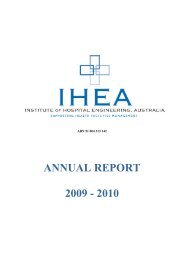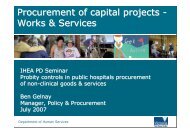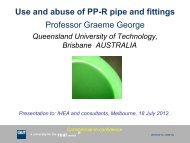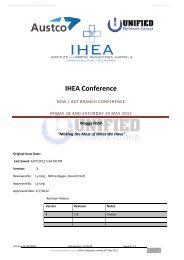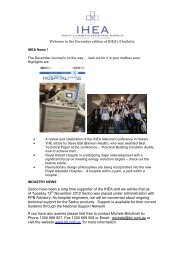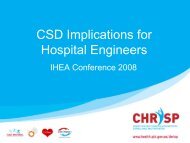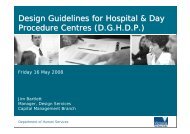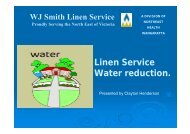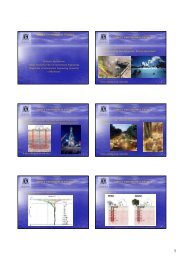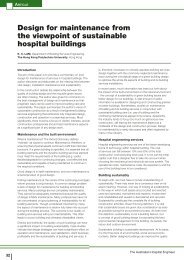Infection Control Principles for the Management of Construction ...
Infection Control Principles for the Management of Construction ...
Infection Control Principles for the Management of Construction ...
You also want an ePaper? Increase the reach of your titles
YUMPU automatically turns print PDFs into web optimized ePapers that Google loves.
Step Four<br />
Concise Description <strong>of</strong> Required <strong>Infection</strong> <strong>Control</strong> Precautions by Class<br />
Class I<br />
Class II<br />
Class III<br />
During <strong>Construction</strong> Project<br />
1. Execute work by methods to minimise raising dust<br />
from construction operations.<br />
2. Immediately replace a ceiling tile displaced <strong>for</strong><br />
visual inspection.<br />
1. Provide active means to prevent airborne dust<br />
from dispersing into atmosphere.<br />
2. Water mist work surfaces to control dust while<br />
cutting.<br />
3. Seal unused doors with duct tape.<br />
4. Block <strong>of</strong>f and seal air vents.<br />
5. Place dust mat at entrance and exit <strong>of</strong> work area<br />
6. Remove or isolate HVAC system in areas where<br />
work is being per<strong>for</strong>med.<br />
1. Remove or isolate HVAC system in area where<br />
work is being done to prevent contamination <strong>of</strong><br />
duct system.<br />
2. Complete all critical barriers i.e. plasterboard,<br />
plywood, plastic, to seal area from non-work<br />
area or implement control cube method (cart with<br />
plastic covering and sealed connection to work<br />
site with HEPA vacuum <strong>for</strong> vacuuming prior to<br />
exit) be<strong>for</strong>e construction begins.<br />
3. Maintain negative air pressure within work site<br />
utilising HEPA equipped air filtration units.<br />
4. Contain construction waste be<strong>for</strong>e transport in<br />
tightly covered containers.<br />
5. Cover transport receptacles or carts. Tape<br />
covering unless solid lid.<br />
Upon Completion <strong>of</strong> Project<br />
1. Clean work area upon completion <strong>of</strong><br />
task.<br />
1. Clean work surfaces with hot water<br />
and detergent.<br />
2. Contain construction waste be<strong>for</strong>e<br />
transport in tightly covered containers.<br />
3. Wet mop and/or vacuum with HEPA<br />
filtered vacuum be<strong>for</strong>e leaving work<br />
area.<br />
4. Remove isolation <strong>of</strong> HVAC system in<br />
areas where work is being per<strong>for</strong>med.<br />
1. Do not remove barriers from work<br />
area until completed project is<br />
inspected by <strong>the</strong> OHS Department<br />
and <strong>Infection</strong> <strong>Control</strong> Department and<br />
thoroughly cleaned by <strong>the</strong><br />
Environmental Services Department.<br />
2. Remove barrier materials carefully to<br />
minimise spreading <strong>of</strong> dirt and debris<br />
associated with construction.<br />
3. Vacuum work area with HEPA filtered<br />
vacuums.<br />
4. Wet mop area with hot water and<br />
detergent.<br />
5. Remove isolation <strong>of</strong> HVAC system in<br />
areas where work is being per<strong>for</strong>med.<br />
Class IV<br />
1. Isolate HVAC system in area where work is being<br />
done to prevent contamination <strong>of</strong> duct system.<br />
2. Complete all critical barriers i.e. plasterboard,<br />
plywood, plastic, to seal area from non-work<br />
area or implement control cube method (cart with<br />
plastic covering and sealed connection to work<br />
site with HEPA vacuum <strong>for</strong> vacuuming prior to<br />
exit) be<strong>for</strong>e construction begins.<br />
3. Maintain negative air pressure within work site<br />
utilising HEPA equipped air filtration units.<br />
4. Seal holes, pipes, conduits, and punctures<br />
appropriately.<br />
5. Construct anteroom and require all personnel to<br />
pass through this room so <strong>the</strong>y can be vacuumed<br />
using a HEPA vacuum cleaner be<strong>for</strong>e leaving<br />
work site or <strong>the</strong>y can wear cloth or paper<br />
coveralls that are removed each time <strong>the</strong>y leave<br />
<strong>the</strong> work site.<br />
6. All personnel entering work site are required to<br />
wear shoe covers. Shoe covers must be removed<br />
each time <strong>the</strong> worker exits <strong>the</strong> work area.<br />
7. Do not remove barriers from work area until<br />
completed project is inspected by <strong>the</strong> OHS<br />
Department and <strong>Infection</strong> <strong>Control</strong> Department and<br />
thoroughly cleaned by <strong>the</strong> Environmental Services<br />
Department.<br />
1. Remove barrier material carefully to<br />
minimise spreading <strong>of</strong> dirt and debris<br />
associated with construction.<br />
2. Contain construction waste be<strong>for</strong>e<br />
transport in tightly covered containers.<br />
3. Cover transport receptacles or carts.<br />
Tape covering unless solid lid<br />
4. Vacuum work area with HEPA filtered<br />
vacuums.<br />
5. Wet mop area with disinfectant.<br />
6. Remove isolation <strong>of</strong> HVAC system in<br />
areas where work is being per<strong>for</strong>med.<br />
28




